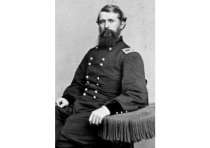
Knoxville and its small military garrison, with a good number of determined citizens, presented a formidable and defiant front, preventing a humiliating capture by Union cavalry that would probably have burned the unofficial capital of East Tennessee.
In June 1863, Col. William P. Sanders conducted a cavalry raid from Kentucky designed to destroy railroad property in East Tennessee. At about 7 p.m. on June 19, Sanders and his cavalry reached the outskirts of Knoxville, where he moved the better part of his force around the town to cut the railroad into Upper East Tennessee before bedding down for the night. At daylight the next morning, Sanders moved his men to the Tazewell Road north of town and reconnoitered the approaches to Knoxville, whose garrison of about 1,000 military effectives hunkered down behind barricades of cotton bales. With Simon Bolivar Buckner gone up the valley to the Clinch River, overall command in Knoxville fell to Col. Robert C. Trigg. A Confederate Treasury agent responsible for southern assets in Knoxville, J. G. M. Ramsey considered the situation so serious that he emptied his vault and sent the contents up the East Tennessee and Virginia Railroad to Abingdon, VA. Sanders noted that defenders numbered perhaps 3,000 (probably an overestimation that included citizens pressed into service), and he also espied at least eight or nine cannon pointed his way on the heights near the Tennessee River. In his report, Sanders briefly stated that he had withdrawn after capturing two pieces of artillery, camp equipage, some horses, and 31 prisoners. The Union commander simply had no time for a prolonged fight, and he needed to get about the business of burning railroad bridges before converging Confederate units found him. By 8 a.m. on June 20, he and his force had quit the action at Knoxville and galloped east to Strawberry Plains. Knoxville and its small military garrison, augmented by a good number of determined southern citizens, presented a formidable and defiant front that day, preventing a humiliating capture by Union cavalry that, unimpeded, would most certainly have taken delight in burning the unofficial capital of East Tennessee.
Tools
Key Facts
- In June 1863, Sanders launched a raid against East Tennessee railroads
- Confederate Treasury agent J. G. M. Ramsey, alarmed, sent the contents of his vault to Abingdon, VA
- Sanders, in a hurry, captured equipment, horses, and 31 men and withdrew




